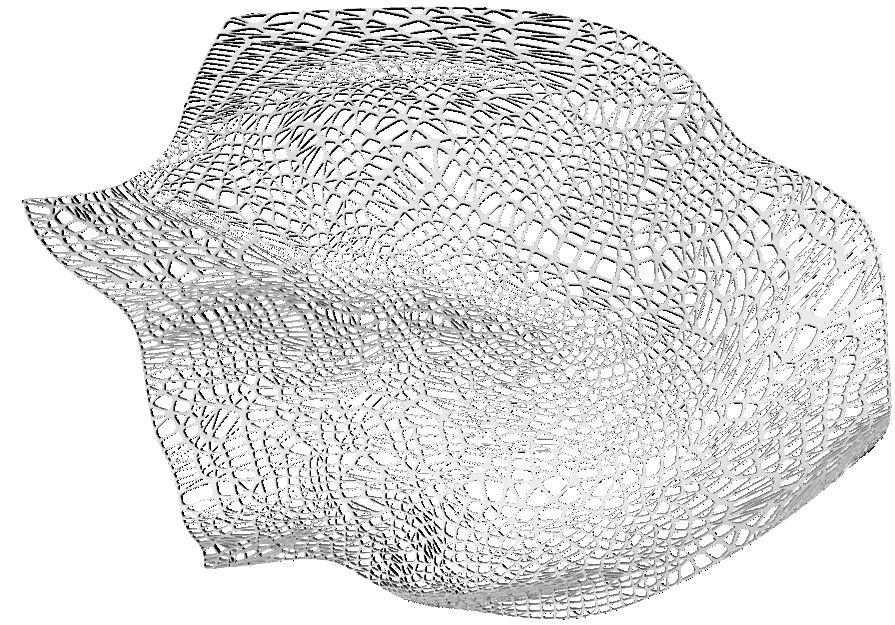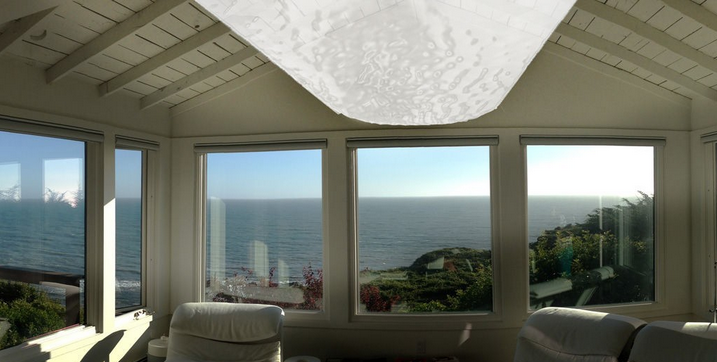A new, ultra-contemporary home in Bolinas, California proudly showcases the extraordinary capacity of 3D printing to quite literally transform the way we live. In an ambitious 3D design and printing architectural project, architect Bryan Allen and artist Stephanie Allen of Oakland, California-based architectural design firm Smith/Allen converted the expansive interior space of a newly constructed home into an interactive work of art. The home — in particular, the large living room — features massive windows with a stunning view with which no ordinary work of art could possibly compete: the Pacific Ocean. Rather than attempting to compete, Smith and Allen created a massive, 3D printed, and ingeniously illuminated drop ceiling that refers directly to and complements the sublime ocean view rather than attempting to upstage it.
The stunning and dynamic work, which its creators titled Liminal Mass, alternates between opacity and translucency throughout the day and into the night. Inspired by a variety of sources from the ocean waves and the undulating light on the water’s surface, to the effect of the tides on the sand, and even the texture of whale skin, layers of intricately cut and 3D printed bioplastic recreate the continuous ebb and flow of the sea and sky beyond the home’s large windows.
Liminal Mass, which is 4 1/2’ wide and 8’ long, is a complex but lightweight structure made possible not only by collaborative, creative vision, but also some pretty considerable technical know-how. The 3D-printed panels, electronics, wiring, and lighting are all attached to a large aluminum frame, which is hung from the ceiling. Anchored to the stable, exposed beams, the piece is designed to sway gently, interacting with the air circulating in the room.
Smith and Allen described the different processes involved in creating Liminal Mass and have provided links, photographs, and instructions on their Instructables page. For the lighting, the duo went with an Arduino setup. They chose an Arduino Mega microcontroller board that uses an Adafruit RF 4-button keyfob (remote).
The major challenge was with the 3D printing. In order to complete the project in a timely manner, Smith and Allen used a combination of their own Type A Machines Series 1 3D Printers and Type A Machines 3D Printing Service. On the Instructables page, they provide incredibly helpful advice on how to make your own 3D printers work together, how to print using a Fusion 360, how to replace a hot end on and add a heated bed to a Series 1, and even how to add Wi-Fi to a pre-2014 Series 1 3D Printer.
If you do decide to create your own version of Liminal Mass, Smith and Allen also explain in detail how they installed the piece, including making recommendations for the best materials and practical, step-by-step advice and measures for checking your work to ensure the work is staying put. They acknowledge some of the major challenges of the project, not the least of which were designing around “the limitations and tolerances” of their 3D printers and also making the separate pieces fit together once they were produced. The design duo also said they would use more powerful LED strips were they to do it all over again, so their accrued wisdom is certainly the gain of anyone who wants to take on a similar project. We can’t imagine, however, that the owners of the Bolinas home in which Liminal Mass is installed have any complaints. The piece truly is resplendent.
Let’ hear your thoughts on this interesting piece in the 3D Printed Lighted Ceiling forum thread on 3DPB.com
